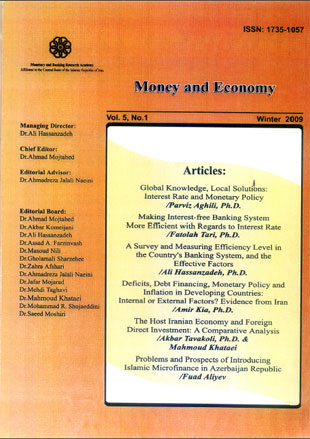فهرست مطالب

Journal of Money & Economy
Volume:5 Issue: 1, Winter 2009
- تاریخ انتشار: 1387/12/20
- تعداد عناوین: 6
-
Page 37Human being always wants to be more efficient in order to achieve more profit or welfare. In economic point of view, efficiency means optimize allocation of resources and maximize use of resources with minimum cost in a given technology.Nowadays, efficiency calculation in organizations or in different industries is a necessary step for comparing the level of competition in domestic and foreign environment of a country. So, the banking system is not an exception. For this reason, calculating the efficiency level of the banks and knowing the effective factors are very important. At first, we look at literature about efficiency and then we try to find how to calculate it and how to compare the efficiency indices in the banking system which affect them. In continuation, we calculate the efficiency level in the banking system of Iran, then with the data from fourteen banks during the years (1996-2003), we evaluate the effectiveness of operational and structural variables on the performance of the banking system, in Iran.
-
Page 65This paper focuses on internal and external factors, which influence the inflation rate in developing countries. A monetary model of inflation rate, capable of incorporating both monetary and fiscal policies as well as other internal and external factors, was developed and tested on Iranian data. It was found that, over the long run, a higher exchange rate leads to a higher price and that the fiscal policy is very effective to fight inflation. The major factors affecting inflation in Iran, over the long run, are internal rather than external. However, over the short run, the sources of inflation are both external and internal.
-
Page 113In this paper fourteen selected developing economies, including Iran, are compared to evaluate the Iranian position in attracting foreign direct investment (FDI). The evaluation is based on economic performance, risk, liberalization policy, and FDI determinant indicators. The results show that the Iranian economy has a sound economic performance and its economic, financial, and political risks are moderate among selected nations. Even though Iran's economic liberalization policy performance seems low, but its economic and policy indictors as the stimulator of FDI ranks the country in middle. The Iranian economy has improved its FDI attraction position through more favorable and flexible economic liberalization policies nationally and internationally since 1993: As a result of these policies, the foreign investments have already started to increase by a moderate rate.

